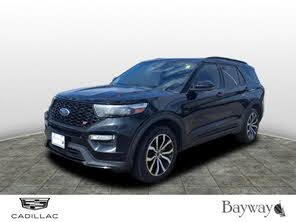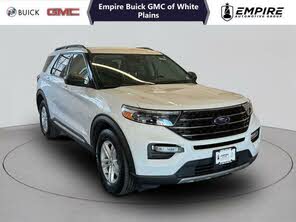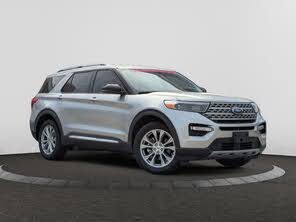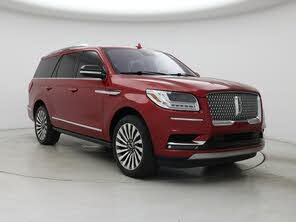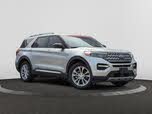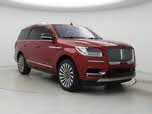2021 Ford Explorer vs 2020 Lincoln Navigator
Overview | |
MSRP$76,185 | MSRP$32,925 |
Average price$43,164 | Average price$28,690 |
Listings257 | Listings2632 |
Ratings & Reviews | |
User Reviews | User Reviews |
Expert reviews8.2 out of 10 | Expert reviews7.5 out of 10 |
Pros
| Pros
|
2020 Lincoln Navigator Reviews SummaryFrom an impressive customer care program to a lineup of luxury vehicles focused on catering to and coddling its clients, Lincoln is carving a niche for itself in a space the automaker has referred to as “quiet luxury.” With the discontinuation of both the Continental and MKZ sedans after the 2020 model year, Lincoln will now rely on a lineup of four SUVs to continue its quest for success. Of those SUVs, the 2020 Lincoln Navigator is the flagship setting the course for the future. | |
2021 Ford Explorer Reviews SummaryThere was a time when everybody in America seemingly drove an Explorer. That may be an exaggeration, but not by much. In its first four years of production, Ford sold over a million examples. In 1998, Ford was selling its second-generation Explorer at a rate of nearly 440,000 per year. Whether your family purchased an Explorer or not, this was the nameplate that invented the midsize SUV segment. Fast forward to the 2021 model year and the Explorer is in its sixth generation. It's now a three-row SUV that clocks in at a maximum of 4,700 pounds, with a price tag north of $50,000 for the Explorer Platinum trim level. Long gone are the days when it was the only game in town. Almost every automaker has a competitor. So how does the Explorer shake out for 2021? | |
No video found | No video found |
Popular Features & Specs | |
Engine3.5L 450 hp V6 | Engine2.3L 300 hp I4 |
Drive Train4X2 | Drive TrainRWD |
Seating Capacity8 | Seating Capacity7 |
Horsepower450 hp @ 5500 rpm | Horsepower |
MPG City16 | MPG City21 |
MPG Highway22 | MPG Highway28 |
Engine | |
Engine Name3.5L 450 hp V6 | Engine Name2.3L 300 hp I4 |
Torque510 lb-ft @ 3000 rpm | Torque |
Horsepower450 hp @ 5500 rpm | Horsepower |
Drivetrain4X2 | DrivetrainRWD |
Fuel Economy | |
MPG City16 | MPG City21 |
MPG Highway22 | MPG Highway28 |
Interior | |
Leather SeatsStandard | Leather Seats |
Seating Capacity8 | Seating Capacity7 |
Key Features | |
Navigation SystemStandard | Navigation System |
Safety | |
Front Crash Overall5 | Front Crash Overall5 |
Side Crash Overall5 | Side Crash Overall5 |
Dimensions & Capacity | |
Cargo Space20.9 cu ft | Cargo Space18.2 cu ft |
Curb Weight5673 lbs | Curb Weight4345 lbs |
Height76.4 in | Height69.9 in |
Length210.0 in | Length198.8 in |
Width93.8 in | Width89.3 in |
Wheelbase122.5 in | Wheelbase119.1 in |
Maximum Payload1620 lbs | Maximum Payload1425 lbs |
Number of doors4 | Number of doors4 |
Maximum Towing Capacity8600 lbs | Maximum Towing Capacity5300 lbs |
Standard Towing Capacity6200 lbs | Standard Towing Capacity |
Overview | ||
MSRP | $76,185 | $32,925 |
Average price | $43,164 | $28,690 |
Listings | ||
Ratings & Reviews | ||
User reviews | ||
Expert reviews | 8.2 out of 10Read full review | 7.5 out of 10Read full review |
Pros & cons | Pros
| Pros
|
Summary | From an impressive customer care program to a lineup of luxury vehicles focused on catering to and coddling its clients, Lincoln is carving a niche for itself in a space the automaker has referred to as “quiet luxury.” With the discontinuation of both the Continental and MKZ sedans after the 2020 model year, Lincoln will now rely on a lineup of four SUVs to continue its quest for success. Of those SUVs, the 2020 Lincoln Navigator is the flagship setting the course for the future. | There was a time when everybody in America seemingly drove an Explorer. That may be an exaggeration, but not by much. In its first four years of production, Ford sold over a million examples. In 1998, Ford was selling its second-generation Explorer at a rate of nearly 440,000 per year. Whether your family purchased an Explorer or not, this was the nameplate that invented the midsize SUV segment. Fast forward to the 2021 model year and the Explorer is in its sixth generation. It's now a three-row SUV that clocks in at a maximum of 4,700 pounds, with a price tag north of $50,000 for the Explorer Platinum trim level. Long gone are the days when it was the only game in town. Almost every automaker has a competitor. So how does the Explorer shake out for 2021? |
Video | No video found | No video found |
Popular Features & Specs | ||
Engine | 3.5L 450 hp V6 | 2.3L 300 hp I4 |
Drive Train | 4X2 | RWD |
Seating Capacity | 8 | 7 |
Horsepower | 450 hp @ 5500 rpm | |
MPG City | 16 | 21 |
MPG Highway | 22 | 28 |
Engine | ||
Engine Name | 3.5L 450 hp V6 | 2.3L 300 hp I4 |
Torque | 510 lb-ft @ 3000 rpm | |
Horsepower | 450 hp @ 5500 rpm | |
Drivetrain | 4X2 | RWD |
Fuel Economy | ||
MPG City | 16 | 21 |
MPG Highway | 22 | 28 |
Interior | ||
Leather Seats | Standard | |
Seating Capacity | 8 | 7 |
Key Features | ||
Navigation System | Standard | |
Safety | ||
Front Crash Overall | 5 | 5 |
Side Crash Overall | 5 | 5 |
Dimensions & Capacity | ||
Cargo Space | 20.9 cu ft | 18.2 cu ft |
Curb Weight | 5673 lbs | 4345 lbs |
Height | 76.4 in | 69.9 in |
Length | 210.0 in | 198.8 in |
Width | 93.8 in | 89.3 in |
Wheelbase | 122.5 in | 119.1 in |
Maximum Payload | 1620 lbs | 1425 lbs |
Number of doors | 4 | 4 |
Maximum Towing Capacity | 8600 lbs | 5300 lbs |
Standard Towing Capacity | 6200 lbs | |
The 2020 Lincoln Navigator, sharing its platform with the Ford Expedition, distinguished itself with unique front and rear styling elements and the Lincoln Embrace lighting system, which sequentially illuminated the SUV to welcome its owner. The Navigator featured a lattice-type grille insert mimicking the Lincoln star logo, an illuminated star in the center, fender vents with simulated exposed front door hinges, and full-width taillights. Black roof pillars, except those framing the windshield, gave the Navigator’s glass a wraparound appearance. The new Reserve Monochromatic Package added a custom look with body-color grille and side mirror enhancements, combined with 22-inch black-painted wheels.
Inside, the Navigator's Dark Slate leather interior, part of the Luxury Package, included Lincoln’s 30-way Perfect Position front seats with heating, ventilation, and massaging functions. The dashboard featured mid-century modern styling cues, digital instrumentation, a 10-inch infotainment touchscreen, and piano-key transmission controls. A panoramic glass roof provided natural light, and high-quality materials were used throughout. The test vehicle, a standard-length Navigator Reserve with 4WD, extra-cost paint, and both the Luxury and Reserve Monochromatic option packages, was priced at $92,385, including the $1,295 destination charge.
The 2021 Ford Explorer, part of Ford's "small, medium, large, XL" SUV lineup, bore a family resemblance to other Ford SUVs, with sporty, raked belt lines and distinctive visages. Depending on the trim, the Explorer featured various grille designs, including black, chrome, and black with a red stripe. The Explorer offered six trim levels: base, XLT, Limited, Limited Hybrid, Explorer ST, and Platinum, with prices ranging from $32,925 to $52,730. The interior provided three rows of seats, with cloth upholstery on the base model and leather available on higher trims. The dash was clean, with familiar gauges, an 8-inch LCD touchscreen, and a center console housing the rotary gearshift.
The Explorer's XLT trim, the most popular, offered better equipment like a power front passenger seat, nicer finishes, and a 6.5-inch instrument panel screen. The Limited trim and higher included leather upholstery. The Explorer's third row was less spacious for adults, but the second row offered 39 inches of legroom. With the third row deployed, the Explorer provided 21 cubic feet of cargo space, and 81 cubic feet with the rear seats folded.
The 2020 Lincoln Navigator featured a twin-turbocharged 3.5-liter V6 engine generating 450 horsepower and 510 lb-ft of torque, surpassing the Ford Expedition's most powerful version by 50 horsepower and 30 lb-ft of torque. A 10-speed automatic transmission transferred power to the rear wheels, with an optional upgrade to four-wheel drive. Lincoln Drive Modes tailored the powertrain to specific driving situations, including Conserve, Normal, Excite, Slippery, Deep Conditions, and Slow Climb with the towing package. The Navigator's maximum towing capacity was 8,700 pounds with rear-wheel drive and 8,300 pounds with four-wheel drive, aided by Pro Trailer Backup Assist.
Acceleration from the twin-turbo V6 was strong, with a subtle engine note. The Navigator averaged 16.4 mpg on the testing loop, with an EPA rating of 18 mpg in combined driving. The SUV's 22-inch wheels and 285/45 tires caused impact harshness over imperfect pavement, despite the standard adaptive damping suspension. The Navigator excelled on open roads with smooth pavement, offering excellent body motion control and a hint of athleticism. Around town, the Navigator felt huge, but a tight turning radius, parking assist system, and numerous camera views improved maneuverability. An automatic hold function helped in heavy traffic.
The 2021 Ford Explorer, weighing 4,345 pounds at its lightest, featured a base 2.3-liter EcoBoost turbocharged four-cylinder engine with 300 horsepower and 310 lb-ft of torque. The Explorer Limited Hybrid offered a V6 hybrid drivetrain with 310 horsepower and 331 lb-ft of torque. Higher trims featured a 3.0-liter EcoBoost twin-turbo V6, delivering 365 horsepower and 380 lb-ft of torque, with the sport-oriented Explorer ST offering 400 horsepower and 415 lb-ft of torque. All trims used a 10-speed automatic transmission with SelectShift capability.
The Explorer's towing capacity ranged from 5,000 to 5,600 pounds, depending on trim, engine, and options. While not exceptional in its class, it was competitive with other SUVs like the Subaru Ascent. The Explorer ST provided the most engaging driving experience, but overall, the Explorer prioritized towing power over performance.
Entering the 2020 Lincoln Navigator required climbing up into the SUV, with available power running boards aiding access. Inside, the test vehicle's 30-way Perfect Position front seats, part of the Luxury Package, offered exceptional comfort, though finding the ideal settings took time. The Navigator's second row could be configured with a three-person bench or two captain’s chairs, with an optional large center console between the captain’s chairs. Triple-zone climate control ensured comfort across all three rows, and the test vehicle included heated rear seat cushions.
The Navigator's third-row seat provided ample legroom and thigh support, making it comfortable for most passengers. Cargo volumes were class-leading, with the standard-length model offering 19.3 cubic feet behind the third row, 57.5 cubic feet behind the second row, and a maximum of 103.3 cubic feet. The longer Navigator L increased these measurements to 34.3, 73.3, and 120.2 cubic feet, respectively.
The 2021 Ford Explorer's base model seated seven, while other trims with second-row captain’s chairs reduced capacity to six. The Explorer offered 39 inches of second-row legroom, ahead of some competitors but behind others like the Kia Telluride and Hyundai Palisade. With the third row deployed, the Explorer provided 21 cubic feet of cargo space, but overall cargo volume with the rear seats folded was 81 cubic feet, putting it in competition with smaller SUVs.
The 2020 Lincoln Navigator's Sync 3 infotainment system was the least impressive technology feature, taking time to load content. However, it offered Apple CarPlay, Android Auto, Lincoln Connect services with a 4G LTE WiFi hotspot, a Lincoln Way smartphone and smartwatch app, and wireless device charging. "Phone As A Key" technology allowed the smartphone to function as the vehicle key. The voice recognition system worked reasonably well but was not as advanced as some competitors.
The Reserve’s Luxury Package included a 20-speaker Revel Ultima audio system with three listening profiles. Additional technologies included a surround-view camera system and a head-up display. The test vehicle did not have the optional Lincoln Play rear-seat entertainment system, which featured dual 10-inch displays, wireless headphones, Slingbox access, Roku media streaming, and Apple and Android compatibility.
The 2021 Ford Explorer's base trim offered an 8-inch touchscreen with AM/FM radio, SiriusXM satellite radio, Apple CarPlay and Android Auto, a 4G WiFi hotspot, Ford’s Sync 3 infotainment system, and a six-speaker audio system. The Limited trim added a 12-speaker Bang & Olufsen audio system and HD radio, with higher trims offering a 10.1-inch touchscreen and up to 14 speakers.
The Explorer provided charging access from two USB ports in the center console and five 12-volt power points. The ST trim replaced one power point with a 110-volt AC power outlet, also available as an option on the Limited. From the Limited trim up, a wireless charging pad was included.
The 2020 Lincoln Navigator came with the standard Lincoln Co-Pilot360 collection of advanced driving assistance systems, including forward-collision warning with pedestrian detection, automatic emergency braking, lane-departure warning with lane-keeping assistance, a blind-spot warning system with trailer coverage, a rear cross-traffic warning system, and automatic high-beam headlights. The Reserve trim added adaptive cruise control with stop-and-go capability. The Navigator's adaptive cruise control and lane-keeping assistance operated with refinement and subtlety.
The Navigator received a five-star overall safety rating from the National Highway Traffic Safety Administration (NHTSA), though the rear-wheel-drive model had a three-star rollover resistance rating. The Insurance Institute for Highway Safety (IIHS) had not tested the 2020 model.
The 2021 Ford Explorer was rated as a Top Safety Pick+ by the IIHS, with top "Good" scores on all crash tests and an "Acceptable" rating for adaptive headlights. The Explorer's base trim included the Ford Co-Pilot360 suite of safety features, such as auto high-beam headlights, blind-spot monitoring, rear cross-traffic alert, lane-keeping assist and alert, forward-collision warning, pedestrian detection, automatic emergency braking, and dynamic brake support.
Higher trims included the Ford Co-Pilot360 Assist+ suite, adding adaptive cruise control with stop-and-go and lane centering, evasive steering assist, a forward sensing system, rain-sensing front wipers, and speed sign recognition.
CarGurus highlights
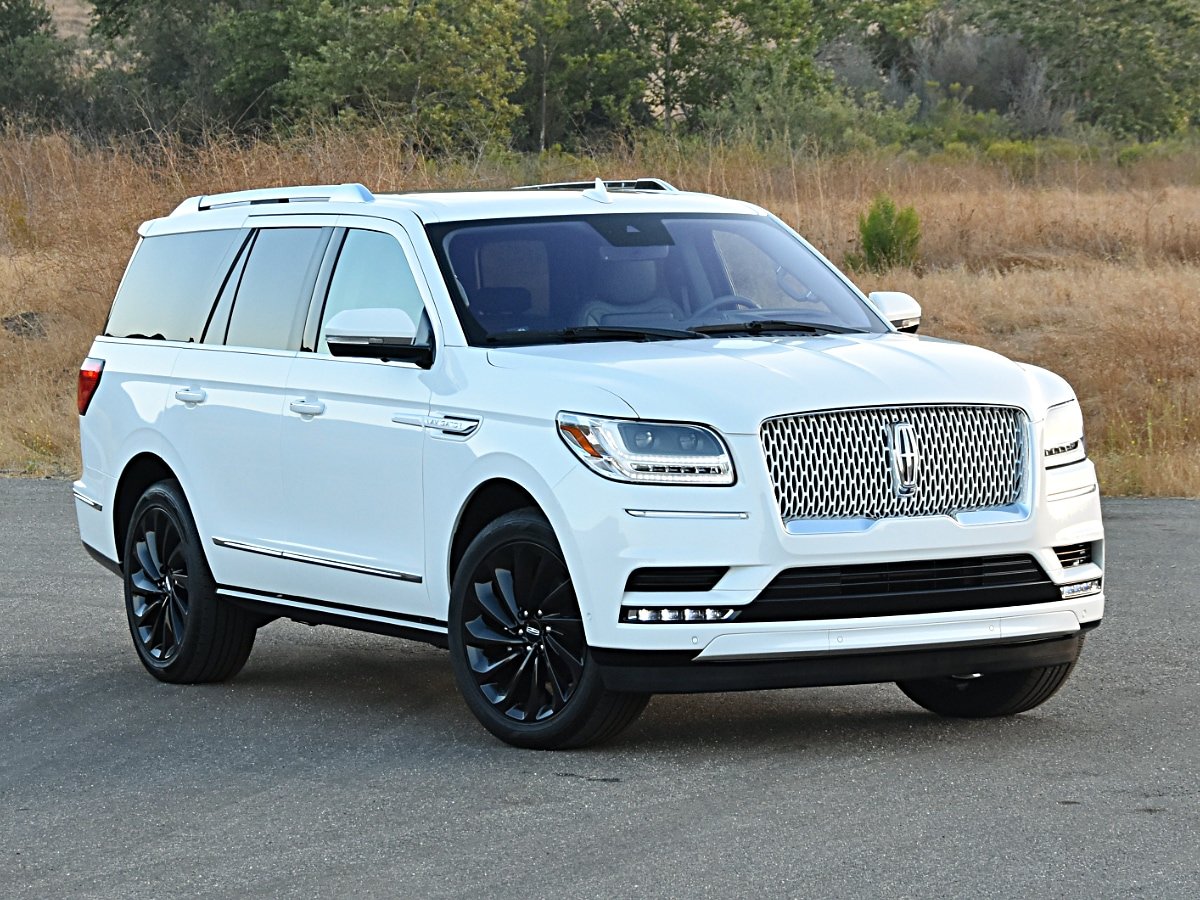
According to CarGurus experts, the overall rating for the 2020 Lincoln Navigator is 8.2 out of 10, while the 2021 Ford Explorer scores 7.5 out of 10. Based on these ratings, the 2020 Lincoln Navigator is the recommended choice for its superior luxury, comfort, and performance.
Choose the 2021 Ford Explorer if:
- You want a more affordable SUV with a range of trim levels and pricing options.
- You need a vehicle with a good balance of performance and towing capacity.
- You prefer a modern infotainment system with a variety of tech features across trims.
Choose the 2020 Lincoln Navigator if:
- You prioritize a luxurious and spacious interior with high-quality materials.
- You need a powerful engine with strong towing capabilities.
- You value advanced comfort features like 30-way adjustable seats and a panoramic glass roof.
CarGurus highlights

According to CarGurus experts, the overall rating for the 2020 Lincoln Navigator is 8.2 out of 10, while the 2021 Ford Explorer scores 7.5 out of 10. Based on these ratings, the 2020 Lincoln Navigator is the recommended choice for its superior luxury, comfort, and performance.
Choose the 2021 Ford Explorer if:
Shop Now- You want a more affordable SUV with a range of trim levels and pricing options.
- You need a vehicle with a good balance of performance and towing capacity.
- You prefer a modern infotainment system with a variety of tech features across trims.
Choose the 2020 Lincoln Navigator if:
Shop Now- You prioritize a luxurious and spacious interior with high-quality materials.
- You need a powerful engine with strong towing capabilities.
- You value advanced comfort features like 30-way adjustable seats and a panoramic glass roof.

By: CarGurus + AI
At CarGurus, our team of experienced automotive writers remain at the heart of our content operation, conducting hands-on car tests and writing insightful guides that are backed by years of industry experience. To complement this, we are harnessing AI to make our content offering more diverse and more helpful to shoppers than ever. To achieve this, our AI systems are based exclusively on CarGurus content, ratings and data, so that what we produce is both unique to CarGurus, and uniquely helpful to car shoppers.














